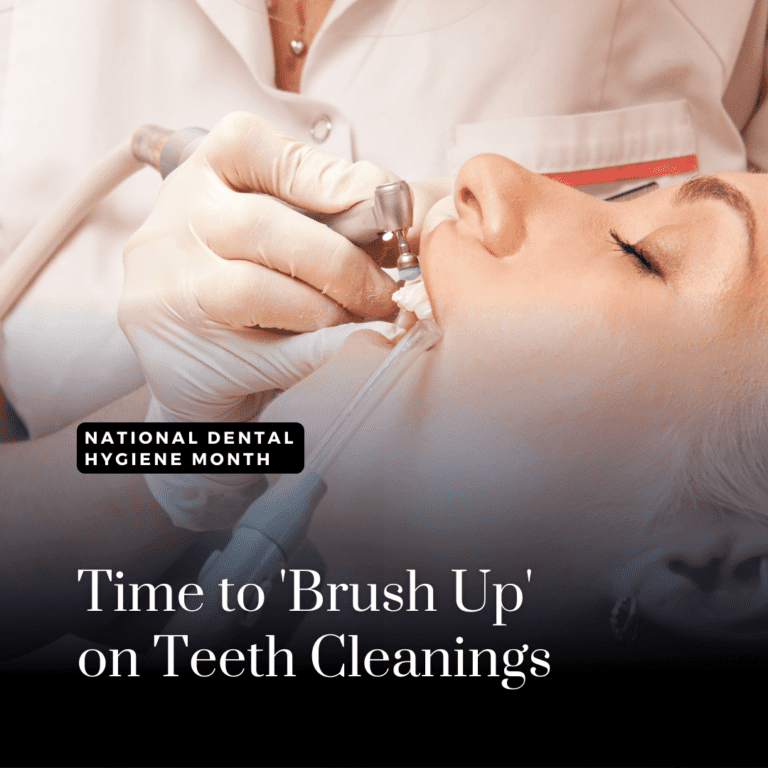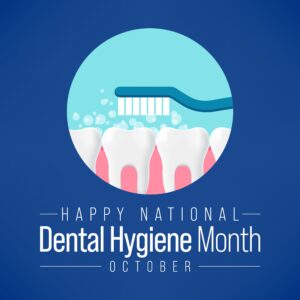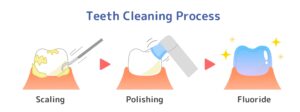National Dental Hygiene Month: Time to ‘Brush Up’ on Dental Cleanings

It’s National Dental Hygiene Month, and we wanted to take this opportunity to let you know how important regular teeth cleanings are for your dental health. Dental cleanings are one of the most important parts of dental hygiene, but they can also be one of the most overlooked. Let’s discuss what you need to know about dental cleanings, why cleaning visits are so important, and steps for a professional dentist cleaning.
Pro*phy*lax*is (n): action taken to prevent disease especially by a specified means or against a specified disease
Dental cleanings, also known as prophylactic cleanings, are performed by a dentist or dental hygienist as a way to prevent common dental diseases such as tooth decay and gum disease. In order to maintain your oral health, the American Dental Association recommends having your teeth professionally cleaned at least once every six months.

Why are dental cleanings important?
A dental cleaning is one of the most basic ways to maintain good oral health, and it’s especially important if you are prone to tooth decay or gum disease. Brushing alone isn’t enough for your teeth, as brushing only removes dental plaque and can miss certain places. During a dental cleaning, your dentist can use special tools to clean hard to reach areas like in between teeth and below the gum line. Special tools can also be used to remove tartar, which is plaque that has hardened in place and cannot be removed by a toothbrush.
Dental Cleaning Steps

- A dentist will begin by examining your mouth for any signs of decay or damage before beginning a cleaning. They will also evaluate your gums for signs of gum disease and perform an oral cancer screening. In some cases, dental x-rays may also be required. The purpose of this exam is to assess your oral health for any potential problems.
- Your dentist or hygienist will then start your cleaning using a technique known as dental scaling. Dental scaling can be performed with a metal scaler or an ultrasonic water scaler. During this process, plaque and tartar will be scraped off the surface of your teeth.
- After the dentist finishes scaling, they will then perform polishing to remove any remaining plaque or tartar on your teeth. This step includes the use of a gritty toothpaste and an electric polishing tool. When performed by a professional, polishing your teeth is safe, however you should never try polishing your teeth at home since doing it wrong can cause enamel erosion.
- Once your teeth have been polished, then they will be professionally flossed to remove any lingering debris. Professional flossing also helps to locate areas you may be missing when you floss.
- To make sure you leave the dentist’s office with a fresh-feeling smile, your mouth will be rinsed with fluoride.
- Finally, you will receive a fluoride treatment to help strengthen your enamel and prevent future plaque accumulation. In most cases, this consists of a foamy gel or paste that is applied and then rinsed. A fluoride varnish may also be used.
To Sum It All Up
Getting your teeth professionally cleaned at least once every six months is important for maintaining good oral health. Brushing alone isn’t enough, as brushing only removes dental plaque and can miss certain places that need to be cleaned. During National Dental Hygiene Month, be sure to schedule your next dental cleaning if it has been longer than six months!






Recent Comments